En esta oportunidad explicare como hacer un vino artesanal con uvas y en este caso específico lo haremos con uvas pesuas. La uva pesgua es un árbol tropical muy común en Venezuela sus frutos son una bayas de color morado de forma ovalada tal como se muestran en la imagen a continuación. Estas uvas tienen un sabor semidulce con mucha astringencia lo que las hace muy diferentes al resto de las uvas.
*In this opportunity I will explain how to make an artisan wine with grapes and in this specific case we will do it with pesuas grapes. The pesgua grape is a very common tropical tree in Venezuela, its fruits are purple berries with an oval shape as shown in the image below. These grapes have a semi-sweet flavor with a lot of astringency which makes them very different from the rest of the grapes.
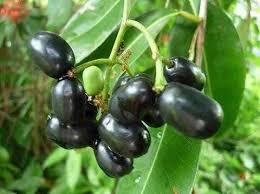
El proceso se llevara a cabo llevando el siguiente esquema tecnológico:
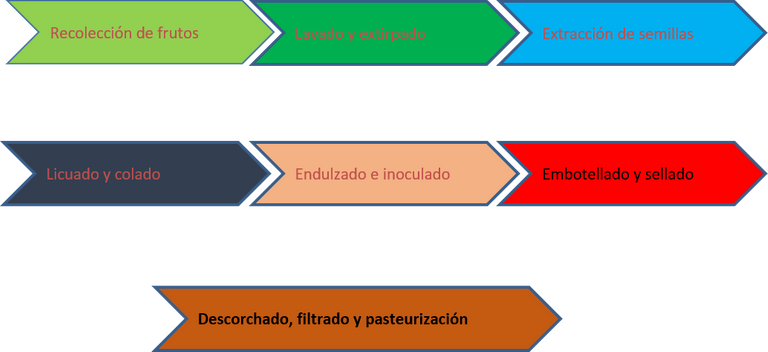
1.- Recolección de los frutos: Lo primero que tenemos que hacer es recolectar los frutos tomando en cuenta que estén sanos y libres de cualquier agente contaminante inorgánico como aceites, combustibles, y otras sustancias químicas que puedan interferir en el proceso de fermentación.
Harvesting the fruits: The first thing we have to do is collect the fruits taking into account that they are healthy and free of any inorganic pollutant such as oils, fuels, and other chemical substances that may interfere with the fermentation process.
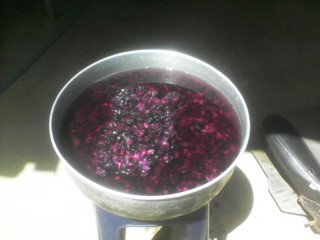
2.- Lavado y extirpado: Una vez tenido los frutos se procede a lavar con agua limpia y fresca enjuagando varias veces procurando retirar todo resto de hojas, tallos y algún otro elemento que pueda estar presente en los frutos. Luego pasamos a extirpar los frutos con las manos teniendo en cuenta que debemos cubrirlas con un guante o una bolsa plástica resistente. Se masajean por un tiempo considerable hasta que las semillas queden totalmente limpias.
Washing and extirpation: Once the fruits have been obtained, they are washed with clean, fresh water, rinsing several times, trying to remove all the rest of the leaves, stems and any other element that may be present in the fruits. Then we proceed to remove the fruits with our hands, taking into account that we must cover them with a glove or a resistant plastic bag. They are massaged for a considerable time until the seeds are completely clean.

3.- Extracción de las semillas: Una vez culminada la extirpación, se procede a retirar todas las semillas con las manos procurando dejar la pulpa libre de ellas.
*Extraction of the seeds: Once the extirpation is completed, all the seeds are removed with their hands, trying to leave the pulp free of them.
4.- *Licuado y colado: Una vez teniendo la pulpa libre de semillas, procedemos a licuarla con la ayuda de una licuadora y vamos colando para retirar todas las partículas sólidas residuales.
** Blending and straining: Once the pulp is free of seeds, we proceed to liquefy it with the help of a blender and strain to remove all the residual solid particles.
5.- Endulzado e inoculado: Listo el mozto (jugo) completamos el contenido de agua requerida según la cantidad de frutos empleados. Para esto debemos medir la cantidad de agua necesaria y debemos calentarla a una temperatura no mayor de 40 grados centígrado (para lo cual debes tener un termómetro de cocina). En esta agua caliente se agrega el azúcar y se disuelve muy bien. Una vez culminado este proceso se agrega una pisca de levaduras (media cucharadita sopera es suficiente). Listo esto se mezcla el mozto obtenido con el agua endulzada e inoculada con las levaduras y listo este paso.
*Sweetened and inoculated: Ready the mozto (juice) we complete the required water content according to the amount of fruits used. For this we must measure the amount of water necessary and we must heat it to a temperature no higher than 40 degrees Celsius (for which you must have a kitchen thermometer). The sugar is added to this hot water and it dissolves very well. Once this process is finished, add a pinch of yeast (half a soup teaspoon is enough). When this is done, the mozto obtained is mixed with the sweetened water and inoculated with the yeasts and this step is ready.
6.- Embotellado: Como último paso en la preparación del vino, se procede a colocar el líquido en un botellón preferiblemente de vidrio sellando con una tapa ajustada la cual debe llevar un a manguerita insertada cuyo extremo final debe ir en una botella con agua tal como se refleja en la imagen que a continuación se presenta. Concluido este proceso se lleva el botellón a un lugar seguro fresco y preferiblemente oscuro para facilitar la reproducción de las levaduras y su acción sobre los azucares.
*Bottling: As the last step in the preparation of the wine, the liquid is placed in a preferably glass bottle, sealing with a tight lid which must have an inserted hose whose end must go in a bottle with water as reflected in the image below. Once this process is finished, the bottle is taken to a cool and preferably dark safe place to facilitate the reproduction of the yeasts and their action on the sugars.
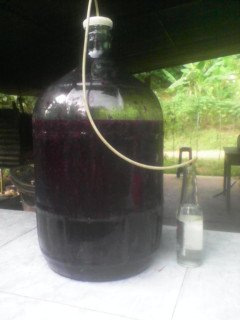
7.- Descorchado, filtrado y pasteurización: Culminado el proceso de fermentación, se procede a destapar el botellón para luego filtrar el líquido con la ayuda de un colador muy fino o una tela muy fina. Listo el filtrado, vamos a pasteurizar, para este paso se debe colocar el vino en un recipiente y levarlo a calentar en la cocina a una temperatura no mayor de 60 grados, esto con el fin de eliminar las levaduras ya que de no ser así siguen fermentado y alterando l sabor del vino. Llegada a esta temperatura, apagar y dejar reposar para luego embotellar y dejar envejecer (añejar) por el tiempo que usted prefiera. De esta forma usted puede obtener un buen vino de manera artesanal y degustar de una buena bebida natural y sabrosa.
Aquí les dejo mi formula: Cuatro (04) kilos de frutos, tres (03) kilos de azúcar refinada, doce (12) litros de agua potable y media (1/2 cucharadita de levaduras.
- *Uncorking, filtering and pasteurization: Once the fermentation process is finished, the bottle is uncovered and then the liquid is filtered with the help of a very fine strainer or a very fine cloth. Filtering ready, we are going to pasteurize, for this step the wine must be placed in a container and raised to heat in the kitchen at a temperature no higher than 60 degrees, this in order to eliminate the yeasts since otherwise they continue fermented and altering the taste of the wine. Arrive at this temperature, turn off and let it rest and then bottle and let it age (age) for the time you prefer. In this way you can obtain a good wine in an artisanal way and taste a good natural and tasty drink.
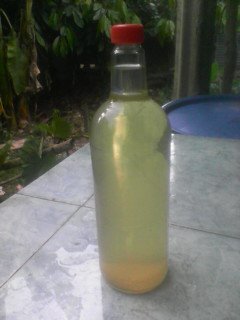


¡Gracias por pasar!

